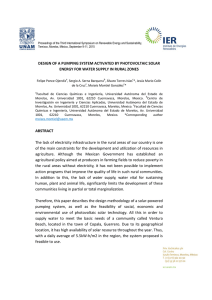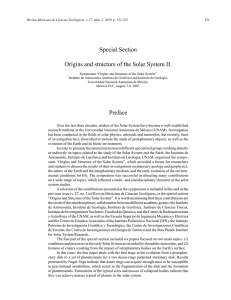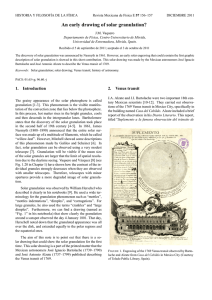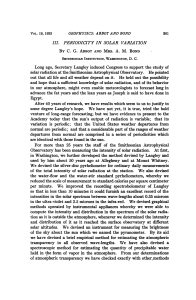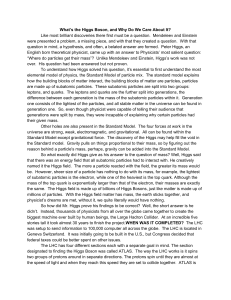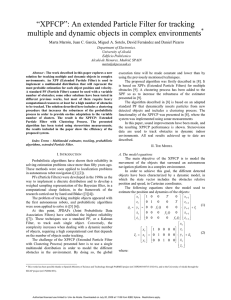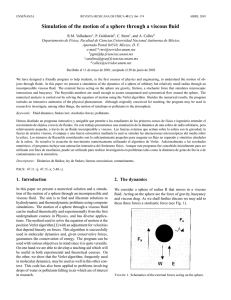Earth`s Dark Matter Halo
Anuncio
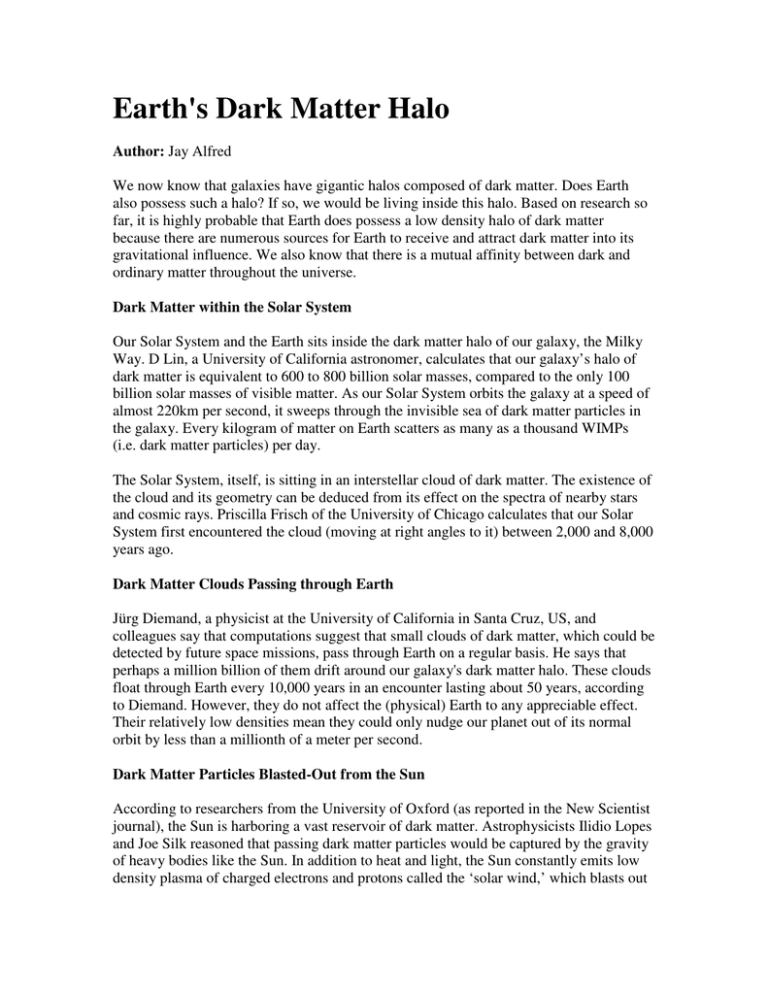
Earth's Dark Matter Halo Author: Jay Alfred We now know that galaxies have gigantic halos composed of dark matter. Does Earth also possess such a halo? If so, we would be living inside this halo. Based on research so far, it is highly probable that Earth does possess a low density halo of dark matter because there are numerous sources for Earth to receive and attract dark matter into its gravitational influence. We also know that there is a mutual affinity between dark and ordinary matter throughout the universe. Dark Matter within the Solar System Our Solar System and the Earth sits inside the dark matter halo of our galaxy, the Milky Way. D Lin, a University of California astronomer, calculates that our galaxy’s halo of dark matter is equivalent to 600 to 800 billion solar masses, compared to the only 100 billion solar masses of visible matter. As our Solar System orbits the galaxy at a speed of almost 220km per second, it sweeps through the invisible sea of dark matter particles in the galaxy. Every kilogram of matter on Earth scatters as many as a thousand WIMPs (i.e. dark matter particles) per day. The Solar System, itself, is sitting in an interstellar cloud of dark matter. The existence of the cloud and its geometry can be deduced from its effect on the spectra of nearby stars and cosmic rays. Priscilla Frisch of the University of Chicago calculates that our Solar System first encountered the cloud (moving at right angles to it) between 2,000 and 8,000 years ago. Dark Matter Clouds Passing through Earth Jürg Diemand, a physicist at the University of California in Santa Cruz, US, and colleagues say that computations suggest that small clouds of dark matter, which could be detected by future space missions, pass through Earth on a regular basis. He says that perhaps a million billion of them drift around our galaxy's dark matter halo. These clouds float through Earth every 10,000 years in an encounter lasting about 50 years, according to Diemand. However, they do not affect the (physical) Earth to any appreciable effect. Their relatively low densities mean they could only nudge our planet out of its normal orbit by less than a millionth of a meter per second. Dark Matter Particles Blasted-Out from the Sun According to researchers from the University of Oxford (as reported in the New Scientist journal), the Sun is harboring a vast reservoir of dark matter. Astrophysicists Ilidio Lopes and Joe Silk reasoned that passing dark matter particles would be captured by the gravity of heavy bodies like the Sun. In addition to heat and light, the Sun constantly emits low density plasma of charged electrons and protons called the ‘solar wind,’ which blasts out from the Sun in all directions at very high speeds to fill the entire Solar System and beyond. The solar wind and the much higher energy particles ejected by solar flares can have dramatic effects on the Earth ranging from power line surges and radio interference to the beautiful and mesmerizing aurora borealis. The composition of this solar wind has been largely analyzed by Science, up to now, to consist of only ordinary matter in the form of plasma. If there is a large dark matter reservoir in the Sun, as certain scientists are convinced, it is a logical next step to expect dark matter particles captured by the Sun from various sources to be also blown out of the Sun in its solar wind — just like ordinary matter particles. Trillions of dark matter particles from the Sun would be hitting Earth every minute. Dark Matter Particles Raining Down from Dwarf Galaxy Astrophysicist Heidi Newberg at Rensselaer Polytechnic Institute and her colleagues suggest that dark matter may be raining down on Earth from the dwarf galaxy "Sagittarius". For eons, the Milky Way has been absorbing and tearing apart Sagittarius, which is about one-tenth the size of the Milky Way. Newberg and other astronomers recently discovered two "tails" or streams of stars flowing-out from Sagittarius. The streams are believed to also contain dark matter particles. Our Solar System sits in one of these streams. We are therefore stuck in the middle of a fast-moving stream of dark matter particles, billions passing through every square meter of the Earth (and our bodies) each second at speeds of over a million kilometers per hour. Day-in and day-out, countless random dark matter particles rain down upon the Earth and through our bodies undetected. Density of Earth's Dark Matter Halo If trillions of dark matter particles are passing through ordinary matter - the Earth and our bodies every few seconds then it would not be difficult for Earth to capture these particles under its gravitational influence. Dark matter could also be already present during the formation of the Solar System – so that ordinary and dark matter worked together to form our Solar System. Perhaps the Pioneer anomaly was also caused by the presence of clumps of dark matter in the Solar System, as conjectured by Marcus Chown. However, it appears (ignoring the effects of any dark energy) that whatever dark matter is present in the Solar System, it must be low in density. Firstly, this is because the planets comply with Newton's gravity laws – unlike the stars at the edge of galaxies. (Dark energy has a repulsive gravitational effect. To what extent this would neutralize the attractive gravitational force of dark matter within the Solar System is a matter of conjecture.) Secondly, the density is low based on extrapolations of the density of dark matter in the local halo – which is roughly 0.3 GeV/cm3. The Earth-Sun distance is roughly 1.5 X 10^13 cm. So the amount of dark matter enclosed within Earth's orbit is approximately 10^40 GeV. For comparison, the Sun's mass is about 10^57 GeV. So the dark matter enclosed is 10^-17 of the mass of the Sun. It therefore has a negligible effect on the orbit of the Earth around the Sun. Based on these estimates, the average dark matter density is much lower (a trillion trillion times lower) than that of rocks, water and other substances typically found on Earth. Is this Density Understated? The numerous sources of dark matter particles suggest that there could be a local excess of dark matter in our Solar System over and above the galactic background. However, since the orbits of the planets comply with Newton's gravity laws very closely, the excess cannot be significant (barring the effects of any dark energy). However, Newton's gravity laws require the mass of the Earth to be input. This mass is computed based on the gravitational acceleration measured at different places on Earth. This assumes from the start that the acceleration is due to only ordinary matter. The contribution of any dark matter on Earth has been ignored. A similar assumption is made when computing the mass of the Sun and the other planets. Scientists have speculated that there could be a large reservoir of dark matter within Earth. David Peat says that the best calculations suggest that our Earth could contain as much as 10 per cent shadow matter. Shadow matter (consisting of supersymmetric particles and objects) is generally considered to be the same as dark matter (which also consists of supersymmetric particles and objects). Halos of dark matter, as large as our Solar System and with the mass of the Earth, were the first structures to form in the universe, according to calculations from scientists at the University of Zurich. If we could allow 10 per cent of the Earth's mass to be in the form of dark matter, this would mean a halo one-tenth the size of the Solar System – this is really huge relative to the size of the visible Earth. The visible Earth would seem like a little stone sitting inside this gigantic halo. Implications Based on the above discussion, there is no doubt that there is dark matter in the Solar System and on Earth. What are the implications? If we are living within a dark matter halo and there is mutual affinity between dark and ordinary matter, do objects on Earth (including our physical bodies) possess low density halos of dark matter? Does dark matter also play a part in the formation of our visible bodies just as it probably did in the formation of the visible Solar System? Can these low density halos organize themselves into life-forms (just like physical matter), survive the death of the physical bodies and evolve independently of life-forms composed of ordinarily visible (or measurable) physical matter? According to plasma metaphysics, a significant amount of dark matter is in the form of a (magnetic) plasma of super (i.e. supersymmetric) particles. See the author's article on Dark Plasma. A low density gas of dark matter particles (which has no electrical properties) probably would not have allowed the development of life-forms composed of dark matter. However, plasma consists of electrically conductive soups of charged particles that respond collectively to electromagnetic forces and are overall (quasi) neutral. Renowned plasma physicist David Bohm was surprised to find that once electrons were in a plasma, they stopped behaving like individuals and started behaving as if they were part of a larger and interconnected whole. He later remarked that he frequently had the impression that the sea of electrons in a plasma was in some sense alive. Unlike particles within atoms, particles in magnetic plasma have long-range effects and correlations; and each particle has an electric field. In other words, the effects of the field become dominant. The invisible spaces between the widely dispersed particles in a low density plasma are not empty – they contain electric fields and dynamic magnetic field lines which twist and turn – generating complex dynamics in plasma. There is a network of filamentary currents in plasma. Hence, even a low density plasma of (supersymmetric, massive) dark matter particles in the Solar System and on Earth could have significant effects on the formation of the Earth and our physical bodies because of its electromagnetic field properties.

